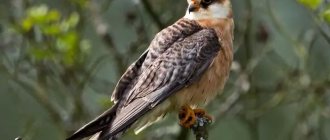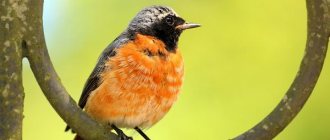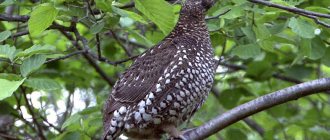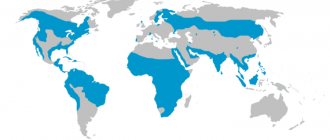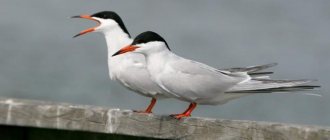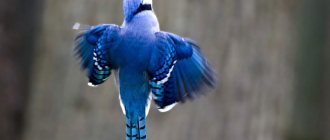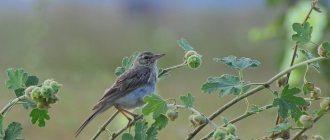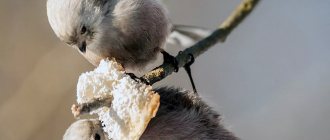- Wild animals
- >>
- Birds
The gyrfalcon is a formidable predator, the world's largest falcon, that rules the barren tundra and deserted shores of the high Arctic.
There he hunts mainly large birds, overtaking them in powerful flight. This name for the bird has been known since the 12th century, where it was recorded in the “Tale of Igor’s Campaign.” Now it is used everywhere in the European parts of Russia. Its origin is most likely connected with the Hungarian word “kerechen” or “kerecheto”, and has come down to us from the time the Pramagyars lived in the Ugra lands. Its plumage changes depending on location. Like other falcons, it exhibits sexual dimorphism, with the female being larger than the male. For centuries, the gyrfalcon has been prized as a game bird.
Origin of the species and description
Photo: Krechet
The gyrfalcon was formally classified by Swedish naturalist Carl Linnaeus in 1758 in the 10th edition of Systema Naturae, where it is included under its current binomial name. During the Late Pleistocene (125,000 to 13,000 years ago), Chronospecies existed. The fossils found were originally described as the "Swarth Falcon". Meanwhile, they turned out to be largely similar to the current gyrfalcons, with the exception that this species is somewhat larger.
Video: Gyrfalcon
Chronospecies had some adaptations to the temperate climate that prevailed in its range during the last Ice Age. The ancient species was more similar to the modern Siberian population or the prairie falcon. This temperate steppe population would have hunted terrestrials and mammals rather than the seabirds and landbirds that make up the majority of the American gyrfalcon's diet today.
Interesting fact: The gyrfalcon is a member of the Hierofalco complex. In this group, which includes several falcon species, there is ample evidence of hybridization and incomplete lineage sorting, making analysis of DNA sequence data difficult.
The acquisition of various genetic and behavioral characteristics in the hierofalcons group unfolded during the last Mikulin interglacial at the beginning of the Late Pleistocene. The gyrfalcons have acquired new skills and adapted to local conditions, which contrasts with the less northern population of northeast Africa, which has evolved into the saker falcon. Gyrfalcons hybridized with saker falcons in the Altai Mountains, and this gene flow appears to have become the origin of the Altai falcon.
A genetic study has identified the Icelandic population as unique compared to others in eastern and western Greenland, Canada, Russia, Alaska and Norway. In addition, different levels of gene flow between western and eastern sampling sites were identified in Greenland. Further work is required to determine the environmental factors influencing these distributions. Regarding plumage differences, research using demographic data has shown that plumage color distribution may be influenced by nesting chronology.
Appearance and features
Photo: Gyrfalcon bird
Gyrfalcons are about the same size as the largest buzzards, but are slightly heavier. Males have a length of 48 to 61 cm and weigh from 805 to 1350 g. The average weight is 1130 or 1170 g, with a wingspan of 112 to 130 cm. Females are larger and have a length of 51 to 65 cm, with a wingspan of 124 to 160 cm , body weight from 1180 to 2100 g. It was found that females from Eastern Siberia can weigh 2600 g.
Standard measurements include:
- the wing chord ranges from 34.5 to 41 cm:
- the tail has a length from 19.5 to 29 cm;
- paws from 4.9 to 7.5 cm.
The gyrfalcon is larger and has wider wings and a longer tail than the peregrine falcon it hunts. The bird differs from the buzzard in the general structure of its pointed wings.
Interesting fact: The gyrfalcon is a very polymorphic species, so the plumage of different subspecies is very different. The coloration can be "white", "silver", "brown" and "black", and the bird can be colored in a spectrum of colors from completely white to very dark.
The brown form of the gyrfalcon differs from the peregrine falcon in that there are cream stripes on the back of the head and crown. The black form has a heavily spotted underside rather than the thin stripe of the peregrine falcon. The species has no sex differences in color, with chicks being darker and more brown than adults. Gyrfalcons found in Greenland are typically completely white except for a few markings on the wings. The gray color is intermediate and is found throughout the entire distribution range; usually two shades of gray are found on the body.
Gyrfalcons have long, pointed wings and a long tail. However, it is also distinguished from other falcons by its larger size, shorter wings that extend 2⁄3 down the tail when the bird perches, and wider wings. This species can only be confused with the northern hawk.
Where does the gyrfalcon live?
Photo: Gyrfalcon in flight
The three main breeding sites are sea, river and mountain. Widely distributed in the tundra and taiga, can live at sea level up to 1500 m. In winter, it migrates to frequent farm and agricultural lands, coasts and to its native steppe habitat.
Breeding range includes:
- Arctic regions of North America (Alaska, Canada);
- Greenland;
- Iceland;
- northern Scandinavia (Norway, northwestern Sweden, northern Finland);
- Russia, Siberia and south of the Kamchatka Peninsula and Commander Islands.
Wintering birds occur as far south as the Midwest and northeastern United States, Great Britain, Western Europe, southern Russia, Central Asia, China (Manchuria), Sakhalin Island, the Kuril Islands, and Japan. Although some individuals have been recorded as nesting in trees, most gyrfalcons nest in the arctic tundra. Nesting sites are usually found among high cliffs, while hunting and feeding areas are more varied.
Foraging areas may include coastal areas and beaches that are heavily used by waterfowl. Habitat fragmentation does not pose a threat to this species, mainly due to the short growing season and climate of the area. Because the rock structure is not disturbed and the tundra is not greatly altered, the habitat for this species appears to be stable.
Winter can cause this species to move regionally. While in more southern climates they prefer agricultural fields that remind them of their northern breeding grounds, usually perching low to the ground on fence posts.
What does the gyrfalcon eat?
Photo: Gyrfalcon bird from the Red Book
Unlike eagles, which use their large size to snatch prey, and peregrine falcons, which use gravity to gain tremendous speed, gyrfalcons use brute force to capture prey. They hunt mainly birds in open areas, sometimes flying high and attacking from above, but more often approaching them by flying low to the ground. They often sit on the ground. Typically, low-speed flights are used in open areas (without trees), where gyrfalcons attack prey both in the air and on the ground.
The diet of gyrfalcons consists of:
- partridge (Lagopus);
- arctic ground squirrels (S. parryii);
- arctic hares (Lepus).
Other prey includes small mammals (mice, voles), as well as other birds (ducks, sparrows, buntings). When hunting, this falcon uses its keen vision to spot potential prey, as almost all animals in the north have specific coloring to avoid detection.
Fun fact: During the breeding season, a gyrfalcon family needs approximately 2-3 partridges per day, which equates to about 150-200 partridges consumed between courtship and fledging.
Gyrfalcon hunting grounds often coincide with the hunting grounds of polar owls. Once a potential prey is located, a chase begins where, more than likely, the victim will be knocked to the ground by a powerful swipe of the claws and then killed. Gyrfalcons are strong enough to withstand long flights when hunting and will sometimes chase down their prey until capture becomes easy. During nesting, the gyrfalcon stores food for use. Sometimes the falcon preys on pigeons (Columba Livia).
Interesting facts about the bird
- In Kievan Rus and the Muscovite state, gyrfalcons were one of the most expensive goods. In those days, white gyrfalcons were owned exclusively by kings or sultans. In falconry, merlins were valued above all other bird species. They were often used to catch cranes and herons, although they are never hunted by gyrfalcons in the wild. In the Middle Ages, the tradition of hunting with gyrfalcons continued, for example, the Danish government sent a special ship to Iceland every year to collect gyrfalcons.
- In Russia today, it continues to be popular to capture gyrfalcons, which are then sent abroad, where one bird can be sold for $30,000 or more.
- Today, gyrfalcons often die from poachers, and in the north the birds often end up in traps that are set openly for arctic fox fishing.
- The gyrfalcon flaps its wings very slowly and appears less agile than, for example, the peregrine falcon, but during a steady flight the bird is capable of developing very high speeds.
- Falconers have always highly appreciated the beauty of the snow-white gyrfalcons that live on the coast of Greenland. Once, the Duke of Burgundy, in order to ransom his son from Turkish captivity, gave 12 white gyrfalcons for him.
Features of character and lifestyle
Photo: White Gyrfalcon
Gyrfalcons prefer a solitary existence, except during the breeding season, when they interact with their mate. The rest of the time, this bird will hunt, forage and roost alone. As a rule, they do not migrate, but move short distances, especially in winter, to more suitable areas where food can be found.
These are strong and fast birds, and very few animals dare to attack him. Gyrfalcons play an important role in nature as predators. They help control populations of predatory animals and help maintain balance in the ecosystems in which they live.
Interesting fact: Biologists who have studied gyrfalcons for decades once thought that these birds were very closely connected to the land where they perched, hunted and nested. Although this is confirmed in many cases, in 2011 it was discovered that some gyrfalcons spend a lot of time in the winter in the ocean, far from any land. Most likely, falcons there feed on seabirds and rest on icebergs or sea ice.
Adults do not tend to migrate, especially in Iceland and Scandinavia, while young birds can move long distances. Their movements are associated with cyclical food availability, for example, birds with white morphs fly from Greenland to Iceland. Some gyrfalcons move from North America to Siberia. In winter, they can cover distances of 3,400 km (from Alaska to Arctic Russia). One young female was recorded to have moved 4,548 km.
Popular message topics
- Sergiev Posad: The Golden Ring of Russia
The history of the founding of the city of Sergiev Posad dates back to a long time ago, when two brothers Stefan and Bartholomew, in search of hermitage and strict monasticism, looked for an excellent place. It was the Radonezh forest, located - Yakuts
Yakuts are the indigenous people of Siberia. They call themselves “Sakha”; several residents call themselves “Sakhalar”. Children from mixed marriages of Yakuts and Europeans are called “sakhalyars”, not to be confused with “sakhalars”. - Mozart
Each of us is familiar with the work of the brilliant Austrian composer Wolfang Amadeus Mozart. But, we are probably all interested in knowing how he achieved such recognition and fame? The future genius was born into the family of a court bandmaster,
Social structure and reproduction
Photo: Wild gyrfalcon
The gyrfalcon almost always nests on rocks. Breeding pairs build their own nests and often use an exposed rock ledge or abandoned nest of other birds, especially golden eagles and ravens. Males begin defending their nesting territory in mid-winter, around the end of January, while females arrive at the nesting sites in early March. Pairs mate over a period of approximately 6 weeks, with eggs usually laid towards the end of April.
Interesting fact: Until recently, little was known about the nesting sites, incubation times, fledging dates and reproductive behavior of merlins. Although much has been discovered in recent years, there are still aspects of the reproductive cycle that remain to be determined.
Birds use their nests year after year, the remains of prey very often accumulate in them, and the stones turn white from excessive guano. A clutch can vary from 2 to 7 eggs, but is usually 4. The average egg size is 58.46 mm × 45 mm; average weight 62 g. The eggs are usually incubated by the female with some assistance from the male. The incubation period averages 35 days, with all chicks hatching within 24-36 hours, weighing approximately 52 g.
Due to the cold climate, the chicks are covered with heavy down. The female begins to leave the nest only after 10 days to join the male for hunting. The chicks fly out of the nest at 7-8 weeks. At 3 to 4 months of age, growing gyrfalcons become independent from their parents, although they may meet with their siblings during the following winter.
Raising offspring
As a rule, the female lays 3-4 eggs. The chicks appear after about a month. Family responsibilities among gyrfalcons are strictly divided. After the birth of the offspring, the female looks after the chicks, warming them, and the male gets food. Moreover, before bringing the prey, he plucks it away from the nest. More experienced females can sometimes leave nests and take part in hunting. The survival rate of gyrfalcon offspring directly depends on the availability of food. An important factor is that the birth of chicks should coincide with the addition of their prey to the family (for example, white hare). After all, a male simply cannot bring large prey to the nest. And small gyrfalcons can die of hunger. Therefore, the number of offspring of these birds varies depending on the season. At the age of 1.5 months, gyrfalcon chicks begin to fly and try to hunt themselves. But they do not fly far from the nest. Grown-up chicks begin independent life in the fall.
Natural enemies of gyrfalcons
Photo: Gyrfalcon bird
Its fairly large size and high flight efficiency make the adult gyrfalcon virtually invulnerable to natural predators. They can be aggressive when protecting their young and will attack and drive off great horned owls, foxes, wolves, wolverines, bears, arctic foxes and eagle owls that encroach on their chicks. Gyrfalcons are not very aggressive towards people, even towards research scientists who study nests to collect data. Birds will fly nearby, make sounds, but refrain from attacking.
Interesting fact: Some Inuit use gyrfalcon feathers for ceremonial purposes. People take chicks from nests to later use them in falconry in the form of so-called eyes.
The only natural predators that pose a threat to the gyrfalcon are golden eagles (Aquila chrysaetos), but even they rarely engage in combat with these formidable falcons. Gyrfalcons are characterized as aggressively harassing animals. Common crows are the only known predators that have successfully removed eggs and young from a nest. Even brown bears were attacked and left with nothing.
People often accidentally cause the death of these birds. This could be car collisions or human poisoning of predatory mammals, the carrion of which the gyrfalcon sometimes feeds on. Also, deliberate killing during hunting is the cause of death of gyrfalcons. Birds that survive to adulthood can live up to 20 years.
Gyrfalcon and grouse lek in winter. Video (00:02:23)
The gyrfalcon is the largest real falcon, the famous and most expensive bird of prey, used since ancient times in falconry. Its main prey is medium-sized birds, often white partridges, since the boundaries of their habitat largely coincide with its area of distribution. In the southern taiga and subtaiga zones, encounters with the gyrfalcon occur only during the period of migrations or migrations; in any case, seeing, much less filming, it in these latitudes is a great success, or rather, an unlikely accident. We noticed him at the edge of the field, where the falcon was looking closely at the black grouse dancing on the ground. For November, a bird flow of such magnitude and numbers is also far from ordinary. Now, watching the video recordings, it’s even difficult to say which of these two meetings turned out to be more significant and memorable.
Population and species status
Photo: Bird of prey gyrfalcon
Due to the wide range of the gyrfalcon, the IUCN does not consider it to be endangered. The bird has not suffered much from habitat destruction, but pollution such as pesticides led to declines in numbers in the mid-20th century, and it was considered "endangered" until 1994. Improved environmental standards in developed countries have allowed the birds to recover.
Interesting Fact: The current population size is expected to remain fairly constant with little fluctuation over the long term. This may be because habitat loss is not a major problem due to the low human impact on the northern environment.
Monitoring of birds of prey is becoming more common, but due to their remoteness and inaccessibility, not all areas are fully covered. This is because birds of prey are a good indicator of the overall health of an ecosystem. By observing gyrfalcons, you can determine whether an ecosystem is in decline and try to restore it.



